by Tom Gaylord
Copyright PyramydAir.com ©2009. All Rights Reserved.

The Walther Lever Action CO2 rifle is a dead-ringer for the Winchester 30/30 model 1894.
This article is about the older model Walther Lever Action rifle. The new gun is powered by larger CO2 tanks that deliver many more shots. Click to see the new gun with either black furniture or nickel furniture.
The Walther Lever Action CO2 rifle is a replica of the most successful lever-action rifle every made--Winchester's famous 1894. The rifle that made the 30/30 a household word and the very model that brought the American hunter into the smokeless powder age.
All Umarex airguns are interesting and well made, but a few stand out as superlative. Without a doubt, the Walther Lever Action rifle is one of them.
I want to try something new and different with this article. Since the Walther Lever Action is a direct copy of a popular firearm, I want to test the firearm as well and document that for you. To keep from confusing everyone, I'll review the firearm after reviewing the pellet rifle. Let's get back to the Walther Lever Action rifle.
For starters
Let's start with appearance, because this gun's got it in spades! It makes a powerful first impression. This is a metal and wood gun--the kind we all dream about. It feels heavy in the hand, yet it has the same compact size as the Winchester it copies. Several years ago, some Daisy employees played a trick on the boys at Winchester by slipping one of their 1894 carbines into a rack at the SHOT Show. As the story is told, it took more than a full day for Winchester to get wise. With the Umarex gun, they might pack up and leave the show and never be the wiser--it's that good.
I conducted an experiment for this review. Instead of building up the rifle beforehand, I just put it into people's hands and listened. Generally, people cannot believe the realism. When they hold it for the first time they often say, "This is an AIRGUN?"
To be completely honest, there are a few plastic parts on the outside of the gun. The sights, the barrel bands and the buttplate are all a dense plastic finished in matte black. You have to test both the sights and bands to know for sure. The rest of the rifle is either wood or metal and looks very correct.
The rifle weighs 7.5 lbs. and is about 38-1/2" long. That puts it within a gnat's eyelash of the specs of the Winchester, which weighs 6.6 lbs. and stretches 37.8 inches! The barrel is 18.9 inches.
The buttplate is a little slick on the shoulder...being made of plastic. It has ridges, but the material is too hard and smooth to grab the fabric of your shirt unless you bring it back into your shoulder. Of course, that buttplate does a whole lot more on this gun because of the mechanism it houses.
Another small quality touch I noticed was in the saddle ring mounted on the left rear of the receiver. Most of us are not going to put a leather thong through this ring to hold the rifle to our saddles, but Umarex put the saddle ring there for the authenticity. For utility, they made the ring tight in its mount so it can't rattle against the receiver, scratching the finish in short order. This small detail says a lot about the overall attention to detail.
The safety is the same crossbolt that Winchester used on their final run of 1894s (the Winchester model was discontinued in 2006, though there are plans to bring it back). Older Winchesters had no safety other than the half-cock notch on the hammer, but pellet rifles will be used by both younger shooters as well as new shooters, so the extra safety is viewed as a plus. And the pellets are loaded by depressing the actual cartridge-loading gate, the same as you would on the firearm. That releases a swing-out door into which the now-familiar Umarex eight-shot metal cylinders are installed. Loading is both fast and easy.
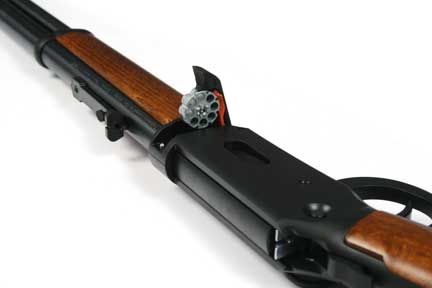
To load, push in on the grooved loading gate. That releases a spring-loaded gate holding the familiar Umarex 8-shot cylinder.
Let's shoot!
The gun shoots even better than it looks! The lever is so slick that more than one person said, "I wish my Winchester was this easy to cock." I had to stop a couple of shooters from bringing the rifle down from their shoulders and cocking it like a Red Ryder. When they learned how easy it is to cock in place, I noticed the pace of their shots increased dramatically.
I've shown the lever all the way forward so you can see the entire range of motion your hand must make to cock and load the gun. This is approximately the same as the Winchester, though this pellet rifle has a lot less work to accomplish with the lever stroke. The pellets are blown into the barrel at the shot (there is no bolt probe), so all you are doing with the lever is cocking the hammer and advancing the magazine.

The lever cycles all the way forward, but the effort is many times less than a Winchester. There's no cartridge elevator or heavy hammer spring to fight against, so the cocking effort is butter-smooth and light.
The external hammer can be cocked and released without using the lever, so you can de-cock the rifle by simply lowering the hammer with your thumb. If you slip off the hammer, though, the rifle will fire, so be certain that you understand how to work the gun safely. And ALWAYS POINT THE MUZZLE IN THE DIRECTION YOU INTEND SHOOTING!
The trigger is crisp but heavy. On our test rifle, it broke between 5 lbs., 2 oz. and 5 lbs., 12 oz. It's a two-stage with a definite second stage stop and almost no creep. Because of the crispness, it felt lighter than it was, but you definitely know that it's there.
With the safety on, you can cock the hammer and dry-fire the gun without discharge. The safety is a crossbolt that prevents the hammer from contacting the valve stem. I would not do this a lot, as I don't know if the mechanism is built for it, but you can sample the trigger safely a time or two in this way.
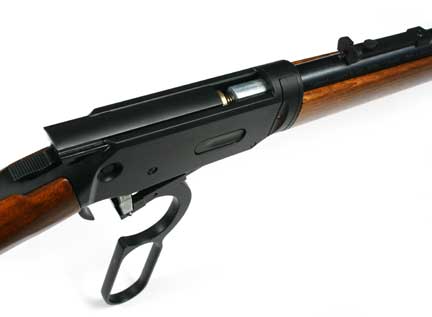
The lever is linked to a slide on top of the receiver that cocks the hammer. This takes the place of the bolt in a firearm. The hammer can also be cocked and uncocked by hand. Since nothing is ejected from the gun, a scope can be mounted quite low over the receiver.
Down range
What you see on target is very respectable for a rifle like this. It shoots more like a target rifle than a sporter. If you're a good shot, the gun rewards you with surprisingly tight groups. I used Chinese target wadcutters for most of my testing, but any good diabolo pellet should work well.
When Wulf Pflaumer, the owner of Umarex, first described this rifle to me, he stressed the accuracy. I told him if it were as accurate as he claimed (hitting a penny with every shot at 20 yards) it would be a real success. It looks like he more than delivered on his promise. First, I tried it offhand at 10 meters because I was more interested in the repeating capability than the accuracy. But when I went downrange and saw that my 24 shots all were grouped inside an inch, I began to suspect I had a real shooter in my hands.
I then benched the rifle. Still using the open buckhorn sights it came with and no adjustments, it drilled five tight shots at 10 meters. Take a look at that bragging group!
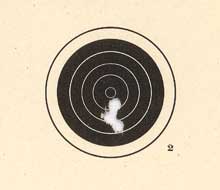
Although it's a sporting air rifle, the 1894 can really group them well! Five Chinese wadcutter target pellets at 10 meters.
As the rifle came from the box, it shot low and left. The rear sight has a sliding elevator with steps to correct elevation, but no way to adjust windage. However, the front sight blade slides sideways in its dovetail after the hood is removed. I moved it slightly to the left to move the strike of the rounds to the right, and it was fixed on the first try.
Both a dot sight and a scope can be mounted to either the long or short rifle. These are Walther products, so you can have everything matching.
Loading
If you own one of these rifles, you're going to go through a lot of pellets and CO2. It's not that the gun uses so much gas--you just shoot it a lot!
To load the rifle, press in on the front of the normal loading gate. That's the oval-shaped piece on the right side of the receiver, in case you wondered. It's in the same place you load the firearm, but with this rifle you aren't finished. The loading gate is a switch that releases the real spring-loaded loading gate. Until you see it pop out of the receiver the first time, you may not be aware that it's there. When swung fully open, place the full cylinder on the pin in the middle of the gate with the pellets pointing forward, then press it closed.
A new type of valve
The 1894 uses two 12-gram CO2 cartridges in a new way. They're installed with their small necks downward. When they pierced, only liquid CO2 flows out. In all other gas guns, great care is taken to ensure that only gas gets to the firing valve. So, why did Umarex go out of their way to use just the liquid?
I don't know all the science behind the decision; but it turns out that by using just the liquid through the valve, they may get more uniformity and perhaps a bit more velocity. For the gun to work, the liquid has to flash to gas somewhere in the firing mechanism. Instead of doing it in the reservoir, as all other gas guns do, they chose to let it evaporate downstream of the valve. As long as it evaporates to gas before it leaves the gun, they get all the power from the charge. It may be more efficient to meter just liquid through the valve.
There were eight magazines' worth of shots at full power from one set of CO2 cartridges. Even when shot rapidly, the gun seemed to not have the usual power loss due to cooling. Magazine No. 9 was still powerful, though not quite at full power. By magazine No. 10, the power dropped off. For plinking, you'll get nine good magazines, which is 72 good shots.
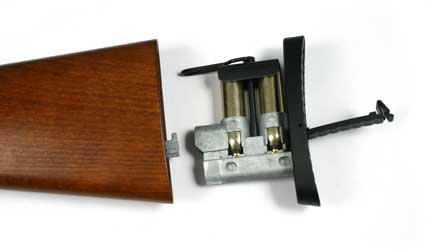
The CO2 carrier is hidden in the hollow butt. A catch at the top of the buttplate unlocks it for removal. The carrier holds pressure outside the rifle and can be installed or removed without the loss of much gas.
To insert the CO2 cartridge, the buttplate is removed, by means of a simple catch. The CO2 cartidge carrier mechanism is then slid straight back and out of the hollow butt. Once out of the gun, there's a black steel plate that holds the large ends of both CO2 cartridges. It must be removed from the carrier. Two cartridges are inserted in their places in the carrier, and the black steel plate is reinstalled to hold them.
The bolt that tensions the plate has a long loop of heavy wire to turn the bolt when the cartridges are being pierced. Once both are pierced (you'll feel it), the wire loop is rotated forward into the butt as the carrier is installed. The final quarter-inch of carrier movement pushes open the valve, admitting CO2 into the gun.
You can remove the cartridge carrier while it's under pressure and gas will not be lost. There will be a sharp hiss or a small pop as it separates from the internals, but it will continue to seal the liquid CO2 while outside the gun. This way, any parent can render the gun inoperative simply by storing the cartridge carrier in a secure place.
.177-caliber Umarex Walther Lever Action CO2 rifle |
|
Muzzle 1' from start screen - 60 degrees F - 1 |
|
7.6-grain .177 Chinese target pellets |
|
High |
623 f.p.s. |
| Low | 598 f.p.s. |
| Average | 610 f.p.s. |
| Extreme spread | 25 f.p.s. |
| Standard deviation | 9 f.p.s. |
| Muzzle energy | 6.28 ft-lbs. |
Safety
With all airguns, safety is an important consideration, but the 1894 illustrates a fact that has been all but lost for generations. The rifle does have a crossbolt safety, as mentioned before. It both looks and functions like the safety on a modern 1894 Winchester, which is both obvious and foolproof. But this gun has something even better!
The exposed hammer on this gun is real in all respects. It's the actual hammer that fires the gun. What that means is that you can easily lower the hammer, rendering the gun safe and uncocked. In fact, the hammer serves as a very obvious cocking indicator--something the legislators have been harping about ever since modern design did away with exposed hammers a century ago. So, going back to the past is a step in the right direction from a safety standpoint.
When you thumb the hammer back the first time, you'll appreciate where the slick lever-action comes from. There's no oppressive mainspring or cartridge elevator linkage to fight, hence the mechanical effort is reduced by many pounds.
Now, let's look at the Winchester!
My Winchester 1894 was made in 1957. Winchester made about 7.5 million of this model between 1894 and 2006. There were many calibers, but .30-30 was by far the most popular and is the caliber for which this rifle is associated. Also, the 1894 Winchester is almost synonymous with the caliber .30-30, so the two have very close ties.
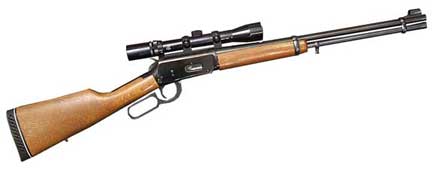
The most commonly seen deer rifle in the American woods for many decades is the Winchester model 1894. The top-ejection pattern of the empty cartridge requires the scope to be mounted on the left side of the receiver. Is this also a solution for left-eye-dominant shooters?
The .30-30 Winchester started life as just the .30 Winchester Center Fire or WCF. At the time it was introduced, the world was rapidly converting from black powder to smokeless powder. In fact, until the advent of smokeless powder, the powder we now call black was just called gunpowder because there really wasn't any other kind. Like Brazil nuts in Brazil are simply called nuts, gunpowder before the advent of smokeless powder was just that. The term black came into being to differentiate it from the many kinds of smokeless powders that all but replaced it.
Cartridge names were descriptive of what they contained during the late black powder era (1865 to around 1900). For example, the .45 Government was also called the .45-70. That designated both the caliber of .45 and the amount of gunpowder (70 grains of black powder) loaded into the cartridge. When the early smokeless powder cartridges came into being, the convention was continued. Hence, the .30-30 cartridge, which was never loaded with black powder, referred to .30 caliber and 30 grains of smokeless powder.
In time the types of smokeless powders proliferated to the point that this naming convention lost its impact. Different powders had to be used in different quantities in a given cartridge, because they produced vastly different pressures. New naming conventions had to be used. But older cartridges, such as the .30-30, kept their original titles, and even Winchester came on board, dropping their .30 WCF designator.
The 1894 is a handy carbine-sized rifle, when it bears the 20-inch barrel that's so common to the model. There were longer barrels to be sure, as well as barrels as short as 14 inches in the Trapper's models. Today, all rifle barrels have to be over 16 inches to be legal (if a firearm has a shoulder stock, it must have a barrel at least 16 inches long to meet federal law), but the 1894 looks best with a 20-inch tube.
The action operates by working the lever located under the receiver. The firearm's lever needs much greater effort than the pellet rifle's lever because a lot more steel parts are moving. And, the .30-30 cartridge is long and heavy compared to a tiny .177 pellet.
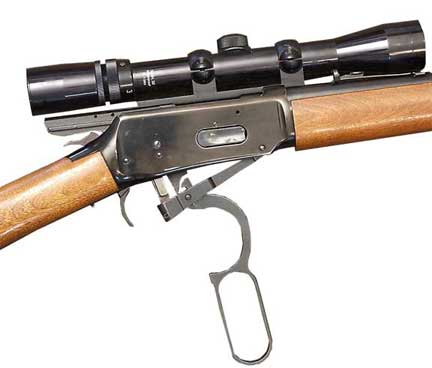
A lot happens when that lever is cycled, which means the 1894 is harder to cycle than the Walther Lever Action pellet rifle. Add to this the greater size and mass of the .30-30 cartridge, and you can see why the rifle is harder to operate.
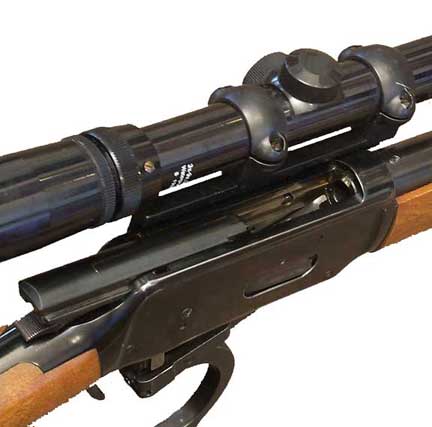
The bolt on the Winchester travels straight back, ejecting the spent cartridge nearly straight up. On this kind of rifle, a scope has to be mounted off to the left to be out of the way of the extraction and ejection.
The trigger on the Winchester is a strange single-stage. There's some take-up, but the rifle lacks a trigger return spring. Once the slack is out, the trigger remains in place. It takes less effort than the pellet rifle trigger, breaking at a very crisp 3.5 lbs.
One aspect of the firearm differs from the pellet rifle. There's a safety switch that tells the rifle the lever is completely closed, indicating that the action is securely locked and the gun is safe to fire. When you grasp the lever, you need to pull it up slightly to depress this switch. Otherwise, the trigger won't work.

When the lever is closed all the way, it pushes the silver button in, releasing the safety so the rifle will fire.
This .30-30 cartridge is considered a very light-recoiling centerfire cartridge for the power it delivers. Indeed, in the light Winchester, the recoil is a small, sharp bump, rather than the heavy punch of a large cartridge like the .30-06. Of course, it feels heavy in comparison to the pellet rifle, which has virtually no kick at all. And, that fact is important when selecting a lookalike rifle like the Walther Lever Action. Everything can be taught using the lighter, cheaper, quieter and safer pellet rifle, and the shooter will be able to transfer a lot of that to the firearm when the time comes.
Accuracy
The .30-30 isn't supposed to be a very accurate cartridge--especially not when shot from a Winchester lever-action! Shooters should be happy with group sizes from 1.5 inches to 2 inches at 50 yards. At best, this is considered a 100-yard gun for deer when using open sights. However, sometimes what is supposed to be and what actually is...are very different.

Here are five shots through a group measuring 0.636 inches center-to-center. This is untypically tight for a .30-30 lever-action at 50 yards.
I want you to know that the above is an exceptional target for me and my rifle. I normally group this one around 1.25 inches at 50 yards, but this day all the stars were aligned. It shows that the potential of the cartridge exceeds what is popularly believed.
Comparison
Comparing the Walther Lever Action to a Winchester .30-30 may seem a bit ludicrous, but I did it for a reason. Obviously, the Walther copies the Winchester closely; and for some owners, it's as close as they will ever get to the firearm. Europeans, for example are hampered by extreme anti-gun legislation, and there are even cities here in the U.S. where citizens rights to have firearms are barred. The Walther Lever Action pellet rifle gives people in these locations the option of owning something very similar, as well as something safe enough to shoot in the house. Sometimes, that's all they want.
Buy With Confidence
Get FREE shipping on qualifying orders! Any order $150+ with a shipping address in the contiguous US will receive the option for free ground shipping on items sold & shipped by Pyramyd AIR during checkout. Certain restrictions apply.
Free shipping may not be combined with a coupon unless stated otherwise.
View Shipping Info
We work hard to get all orders placed by 12 pm EST out the door within 24 hours on weekdays
because we know how excited you are to receive your order.
Weekends and holiday shipping times will vary.
During busy holidays, we step our efforts to ship all orders as fast as possible,
but you may experience an additional 1-2 day delay before your order ships.
This may also happen if you change your order during processing.
View Shipping Times
It's important to know that due to state and local laws, there are certain restrictions for various products.
It's up to you to research and comply with the laws in your state, county, and city.
If you live in a state or city where air guns are treated as firearms you may be able to take advantage of our FFL special program.
U.S. federal law requires that all airsoft guns are sold with a 1/4-inch blaze orange muzzle
or an orange flash hider to avoid the guns being mistaken for firearms.
View Shipping Restrictions
Get the most out of your equipment when you work with the expert technicians at Pyramyd AIR. With over 25 years of combined experience, we offer a range of comprehensive in-house services tailored to kickstart your next adventure.
If you're picking up a new air gun, our team can test and tune the equipment before it leaves the warehouse. We can even set up an optic or other equipment so you can get out shooting without the hassle. For bowhunters, our certified master bow technicians provide services such as assembly, optics zeroing, and full equipment setup, which can maximize the potential of your purchase.
By leveraging our expertise and precision, we ensure that your equipment is finely tuned to meet your specific needs and get you ready for your outdoor pursuits. So look out for our services when shopping for something new, and let our experts help you get the most from your outdoor adventures.
View Service Info
Shop and purchase with confidence knowing that all of our air guns (except airsoft) are protected
by a minimum 1-year manufacturer's warranty from the date of purchase unless otherwise noted on the product page.
A warranty is provided by each manufacturer to ensure that your product is free of defect in both materials and workmanship.
View Warranty Details
Didn't get what you wanted or have a problem? We understand that sometimes things aren't right and our team is serious about resolving these issues quickly. We can often help you fix small to medium issues over the phone or email.
If you need to return an item please read our return policy.
Learn About Returns
Get FREE shipping on qualifying orders! Any order $150+ with a shipping address in the contiguous US will receive the option for free ground shipping on items sold & shipped by Pyramyd AIR during checkout. Certain restrictions apply.
Free shipping may not be combined with a coupon unless stated otherwise.
View Shipping Info
Want More?
Join Our Email List for News and Deals!
Join the Pyramyd AIR mailing list: Our e-mails are filled with new products, deals, sneak peeks, tips and tricks, contests and more - sign up today!
Text JOIN to 91256 and get $10 OFF Your Next $50+ Order!
* By providing your number above, you agree to receive recurring autodialed marketing text msgs (e.g. cart reminders) to the mobile number used at opt-in from Pyramyd AIR on 91256. Reply with birthday MM/DD/YYYY to verify legal age of 18+ in order to receive texts. Consent is not a condition of purchase. Msg frequency may vary. Msg & data rates may apply. Reply HELP for help and STOP to cancel. See Terms and Conditions & Privacy Policy.